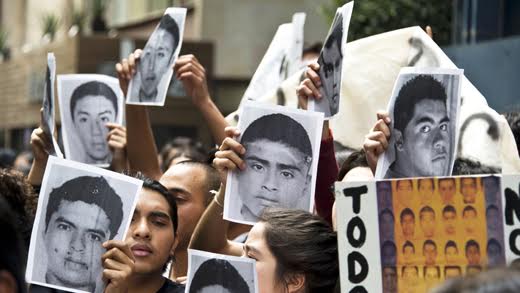
The disappearance of 43 students in Iguala last year on September 26 remains an open, festering wound in Mexico. While many Mexicans suspect that security forces killed the students, President Enrique Pena Nieto blames drug gang members for killing the students. Xavier Roble’s “Ayotzinapa: chronicle of a state crime” clears up any doubt about what really happened to the 43 students.
Students from the Ayotzinapa Normalista school went to Iguala to raise money to finance a trip to Mexico City. Every year, Mexicans march in the capital to honor student protestors who were massacred by the army in Mexico City in 1968, and the young students, mostly in their early 20s, wanted to be there. According to surviving students Jose and Omar, heavily armed police, waiting for the young defenseless students when they arrived in Iguala, opened fire on the buses carrying them. Video evidence taken by cell phones confirms this. Police took away surviving students who were never seen again.
The ambush took place within blocks of the base of the 27th infantry battalion which never tried to rescue the students, despite crackling gunfire ripping through the night air. Soldiers only appeared two-three hours later to search for wounded students in the local hospital, according to Omar. Soldiers verbally abused the surviving students, calling them common criminals. As they were leaving, the green clad infantrymen threatened to let the police take care of the students. “They were going to let the police do their dirty work”, remarked Omar.
This begs the question of why police would want to disappear 43 young students? Robles suggests that the students were killed for political reasons. The Normalista schools, established after the Mexican revolution in 1926 for students from indigenous, campesino and poor backgrounds, had always been hotbeds of resistance against social injustice. Required readings in these schools include Pablo Neruda, Eduardo Galeano, Maxim Gorky, Karl Marx and Vladimir Lenin. These schools have produced a steady stream of leftwing political activists and figures, including famed 1970s guerrilla Lucio Cabanas. Guerrero, the state where the students were disappeared, has been in a continuous rebellion against central and state governments aligned with drug cartels, which have pursued neo-liberal policies.
For many years now, police, soldiers and drug cartels have carried out a campaign of terror against environmentalists, peasant and union activists and leaders in Guerrero. Many have turned up dead.
Robles places the disappearance of the students in Iguala within a broader context where Mexican governments at the state and national levels have melded with drug cartels, turning the country into a narco state.
“Ayotzinapa: chronicle of a state crime” is an eye opening, elegantly crafted documentary that sheds light on what happened that tragic night in Iguala on September 26th of last year. While not currently available on DVD or Blue Ray, it is making the rounds of the world film festival circuit – recently being screened in Vancouver, Canada. It will be shown in 150 cities in 26 countries, including the upcoming Havana festival of New Latin American film in December. While it is a long documentary to sit through at 140 minutes, it is a worthwhile view.
Trailer:
Documentary: Ayotzinapa: chronicle of a state crime
Director: Xavier Robles
Production company: El Principio Producciones, 140 minutes
Spanish with English subtitles.
Photo: Still from film










